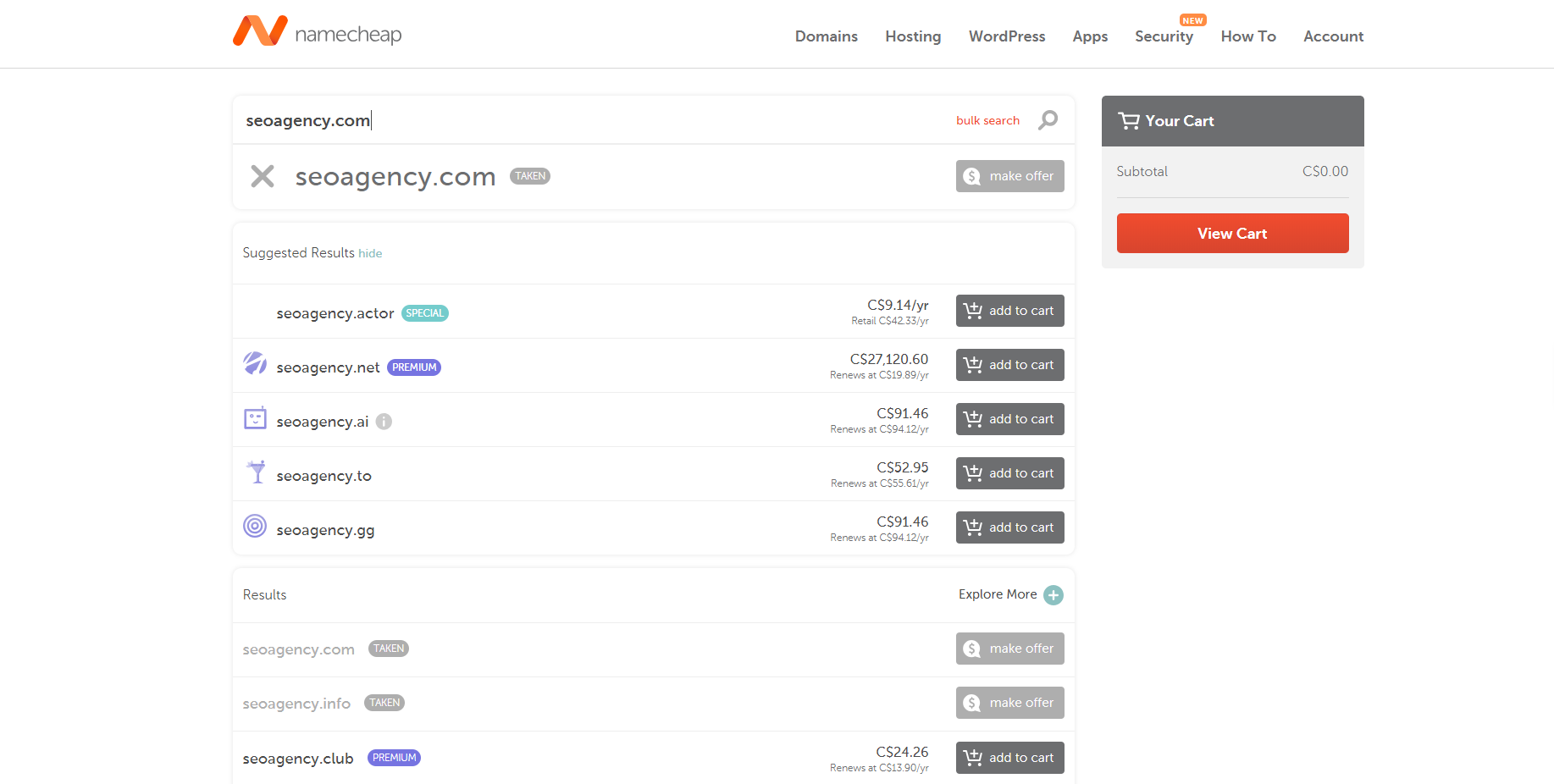The first impression your website makes on users can make or break your business. In fact, 94% of users agree that mistrusting websites normally comes from design issues.
Think about it — an outdated and unprofessional website will make people think that your brand and customer service is no better.
This why it’s crucial to invest into a great website. But, figuring out costs is the first obstacle. There’s agencies that will build and host a site for you, drag-and-drop builders, and many other approaches you can take.
Which one is best depends on your goals and budget. That’s why ahead, you’re going to learn how to assess how much you should spend to get the best deal.
Hosting, domains, and SSL
Before a website can be designed, you need to choose a domain name, configure a web host, and set up an SSL certificate. Don’t worry if you don’t know exactly what these are, I’ll be explaining them in a moment.
How much does web hosting cost?
The first step a designer or yourself will take when building your website is getting the hosting. These are companies that host your website on their servers for the world to see. The process looks something like this:
There are many different plans to choose from, and they all affect web hosting costs. Some of the most common are:
- Shared hosting: The most budget friendly option, and can be purchased for a few dollars per month. Your website is put on servers with others, but unfortunately comes at a performance cost.
- Cloud hosting: Your website will be placed on a cloud server, giving it more resources, up-time, and security. This is normally priced slightly more than shared hosting — about $10-15/month — but vastly superior in performance. It’s a great bang-for-your-buck choice.
- VPS: One step up from cloud is storing your website on a virtual private server. It offers the power of a dedicated server, but with shared elements. You’ll be spending around $50/month.
- Dedicated hosting: Finally, dedicated hosting gives you an entire server to yourself. This is the most expensive package you can get, and is ideal for enterprise level sites with hundreds of thousands of monthly users. Expect to be dishing out at least $100/month for this type of hosting.
How much does a web domain cost?
Next, you need a domain name. This is the URL that users will type in to visit your website. Many will run you as little as $15 for an entire year. They’re very affordable.
Certain expired domains and ones with rare names can cost thousands, though.
To keep things simple, it’s best to get your domain along with hosting. This saves you from having to propagate it to separate nameservers.
You can visit domain registrars and check the availability of a domain if you already have some ideas. Take Namecheap for example. Type in any URL and it will let you know if it’s available at the moment.
There are endless extensions to choose from, but “.com” is the most trusted. Located based extensions, such as “.ca”. or “.co.uk” are perfectly fine if another isn’t available.

SSL certificate
In the past, an SSL(Secure socket layer) certificate was mostly only importantly for e-commerce stores. This improved security and kept them compliant with payment gateways.
However, Google recently rolled out changes in July that warns users if they are entering any website without an SSL.
These certificates are commonly included with hosting plans, and can also be purchased for $50 to $100 separately.
Website design costs
The bulk of website creation costs comes from the main design.
Many agencies and freelancers build off of templates — pre-built code or themes that they expand upon. This is especially common for WordPress websites, and normally come at a reduced cost for the quicker turnaround time.
You can get yourself a professional looking website theme for WordPress or other platforms for $50 to $100. In the case you wanted to design the site yourself, you could save a lot of money by taking this route. But, it’s not as easy as it seems.
As nice as it would be to install the theme in the click of a button and be done, it still requires expertise. You need to know how to navigate theme options, while also understanding UX and design principles.
This is a big portion of a website price — the time and energy you’re saving by having an expert do it for you.
On the flip side, websites built from scratch can have custom features and are easier to tailor to your exact needs. They require more skill, elbow grease, and time, thus you should expect to be dishing out more money for one.
Website content
The web design is only one of many potential costs when purchasing a website.
While it is usually the bulk of the work, your site will be blank unless you have content — that’s where copywriting comes into play. You can expect to be paying approximately $150 per page, or $750 for a 5 page website.
Blog posts however are a completely different style of writing. These have the potential to drive your website organic traffic, and generate leads or sales as a result. It’s common for blog posts to range from $0.05/word to $0.35/word because of this. Check out the Editorial Freelancers Association rate page to get a better idea of what you should be charged.
I wrote a guide to content marketing if you’d like to save money by doing it yourself.
A study in 2011 found that users are more likely to contact businesses that use images on their website. Photos can be used strategically to relate to customers and to bring out specific emotions.
Stock images from websites like Pixabay and Unsplash are completely free, and will save you from investing into expensive pictures.
Ensure that you always ask, or include in the contract, that the designer has the rights to use the images they add. If you decide to pay for images, they will be $10 each on average.
And what’s a website without a logo? While some brands pull it off, logos are proven to increase brand loyalty and awareness. Services like 99designs can help you get affordable logos if you don’t have the budget for expensive designers.
Some logos range upwards to thousands of dollars on the high end of the scale or $5 on the low end. You can expect to be paying between $275 to $1,000 on average, though.
eCommerce
One of the most expensive form of websites and functionality is e-commerce. The main reason for this is because a well designed e-commerce store can help generate you many times your original investment. If you sell online, a well designed store is one of the best investments you can make. According to a study by Statista, 10% of Canadians shop online once per week.
Now, the individual platform that you choose will influence the price heavily. An out-of-the-box solution like Shopify or BigCommerce will be more affordable, as these use templates and require little to no extra development.
WordPress and Woocommerce is another common platform, but is a little more tricky to set up. Since WordPress is also highly customizable, it’s normal to pay more for an e-commerce shop using it as its core.
While those solutions have become the go-to for most ecommerce entrepreneurs, Magento was the most popular for many years. It required serious development capabilities, though. It wasn’t uncommon to spend tens of thousands of dollars on a custom store.
You also need to consider if you’d like to upload products yourself or include it within the project fee. These are some benchmark rates to keep in mind:
- Up to 10 products: $750
- Up to 100 products: $3,500
- Over 100 products: $7,000
Some web designers may ask for a percentage of goods sold as an extra fee, as well. This should not exceed more than a few percent, as it will cut into profit margins and overall revenue. Payment gateways like PayPal take this exact approach by deducting 2-3% from every transaction. This amount will gradually add up for the designer, but it’s nothing you will notice.
Website Add-Ons
While the design of the website is the bulk of the cost, additional add-ons are commonly included in packages or charged separately. These add-ons are dependant on your business and individual goals.
Features like forms, image galleries, and live chats are very common. While some can be installed for free, you are paying for the convenience of having it configured for you. For those trying to bootstrap web design costs, research if there add-ons you could implement once the website is delivered.
More advanced and technical features, such as membership logins, gateway content, affiliate programs, and calendar scheduling will come at a higher cost. Using a website calculator app, this an estimate for a combination of add-ons. As a general rule, the more complex the feature — the more you should expect to pay a developer.
Things to consider when choosing a website building platform
Not all website builders are the same. Sure, they have one main function — to build a website — but, they have individual features, pricing, and the follow things to consider.
What’s your budget?
It’s normal to be budget sensitive when looking to get a website built. You could be possibly dishing out thousands of dollars or over five figures, which is a serious investment. Your budget will directly affect the quality and customization involved.
Lower budgets should opt for all-in-one solutions like Squarespace or Shopify, specifically if you’re having an e-commerce store created. This will save you from having to spend more on having e-commerce functionality configured on platforms not made for it. WordPress and Woocommerce with an affordable host is another great option.
WordPress in general can be installed quickly and easily on all major hosting providers, but extra customization/add-ons can drastically increase the project cost. You can reduce this by learning to implement features yourself, however. Similarly, Weebly and Wix are other affordable drag-and-drop style website builders that are budget friendly.
A platform like Magento will almost always require you invest heavily into the development, so it’s better for businesses with large budgets.
How comfortable are you writing code?
Platforms like Shopify are built off of the liquid language, while something like WordPress is based off PHP. It’s not rare to experience problems with themes, plugins, or other aspects that require you to know some degree of programming skills.
Otherwise, you’ll have to spend money on having a professional help you or tinker with it for hours.
If you don’t have a programming background, out-of-the-box solutions are a safe choice. They are easy to use and are made for less technically skilled users. The same goes for drag-and-drop builders, which essentially do all of the coding for you behind the scenes.
For those that do harness coding skills, WordPress, Magento, and most major platforms will give you the ability to edit everything to your heart’s desire.
How much flexibility would you like?
Nothing ever remains the same in business. You might have a brilliant new idea months from now that you’d like to bring to life. However, the platform you choose must be equipped to allow you to execute it.
For example, many entrepreneurs are beginning to focus more on inbound marketing now that it costs 61% less than outbound. As a result, they’re creating content and blogging more often.
What if their website platform didn’t have a good CMS like WordPress does? They’d have to get a custom one built or work with what they already have.
So, think ahead. If you need flexibility, platforms such as WordPress, Weebly, and Wix are great because they’re made for every use. If you chose BigCommerce for example, you’re essentially stuck only being able to make an e-commerce store.
Do businesses need websites?
Yes, every modern business needs a website. We’re in a digital age, and if you don’t follow trends, you’re going to fail.
Look at what happened to Sears. They didn’t stay up to date, and paid the price for it by relying on a strategy that was decades old.
You will be able to generate leads and revenue by having a website, and it improves your brand image. Customers will trust you more, and it provides them with useful information to increase conversion rates.
Summarising what’s best for you
There are many different factors to consider when building or purchasing a website.
The first of which is time. Do you need your website live before a certain date? Then it may be best to hand the project off to a designer or team if you aren’t experienced to launch it in time.
For those with more leeway, taking the time to create a website yourself can teach rewarding skills and keeps costs low. That brings me to my next point.
Budget. Lower budget businesses will find productized web design services, simple sites with less features, and drag-and-drop builders ideal. These won’t cost as much, while still providing you with a good base to build off of in the future.
Higher budgets can enjoy more add-ons, customization, and support.
You also want to consider the long term nature of your website.
Can your host support thousands or more users per day if it grows to that level? Do the servers have the necessary RAM and CPU to manage several large websites at once?
Smaller sites should begin with shared or cloud hosting before moving up to more expensive packages that larger businesses will be better starting with.
At the end of the day, these are all good benchmarks to start with. Everyone’s situation is different, which why I highly recommend you use a website cost calculator to determine exactly how much a website would cost for your individual needs.
Contact me if you require content writing services to help grow your traffic, leads, and revenue.


